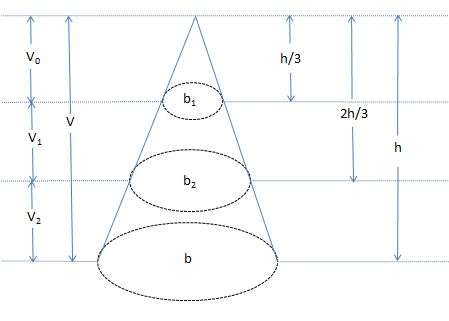Question #6b9d0
1 Answer
In fact the ratio is
Explanation:
Refer to the figure below

Since the 2 planes divide the cone in 3 parts we can obtain 3 ratios. But I presume that
Just not to create confusion, be noticed that
The volume of a cone is given as
Finding
#V_2=V-(V_0+V_1)=(bh)/3-(b_2*(2h)/3)/3=(bh)/3-2/9*(b_2*h)#
Notice that
#->(b_2)/b=(pi*r_2^2)/(pi*r^2)=(r_2/r)^2# and since#r_2/r=((2cancel(h))/3)/cancel(h)=2/3#
#=>(b_2)/b=(2/3)^2# =>#b_2=4/9*b#
So
#V_2=(bh)/3-2/9*(b_2*4/9b)=(27bh-8bh)/81# =>#V_2=(19*bh)/81#
Finding
#V_1=V-V_0-V_2=(bh)/3-(b_1*h/3)/3-(19*bh)/81#
But as we saw above
#b_1/b=((cancel(h)/3)/cancel(h))^2=(1/3)^2# =>#b_1=b/9#
So
#V_1=(bh)/3-b/9*h/9-(19*bh)/81=(27*bh-bh-19*bh)/81# =>#V_1=(7*bh)/81#
So the asked ratio is
#V_1/V_2=((7*cancel(bh))/cancel(81))/((19*cancel(bh))/cancel(81))=7/19#

